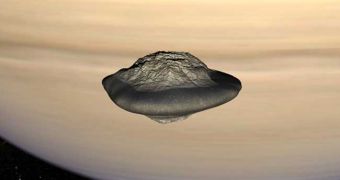Such strange flying-saucer-shaped objects mostly common in Saturn's rings have puzzled scientists. It appears that they form from gathering particles of ice and dust from the rings, much in the same way planets form by buiding up matter from accretion disks spinning around stars, and could provide us with valuable insight on how planetary systems form.
The planets in our solar system, such as Earth and Jupiter, orbit the Sun in an approximately flat plane corresponding to the star's equatorial region. Saturn's rings behave in a similar way, by orbiting the planet in a flat disk of matter.
Saturn, presents two oddly shaped moons inside its rings, Atlas and Pan, which have massive ridges in their equatorial areas, as high as 6 to 10 kilometers, which makes them look like flying saucers. Images from NASA's Cassini spacecraft, reveal that the two moons have about 20 kilometers across from pole to pole. Theories about how they might have formed include models in which these ridges might have risen as a result of the fast spin rates presented by the two moons that take about 14 hours to complete a rotation, while Earth completes a rotation every 24 hours.
However, recently, a new model on Saturn's moon formation proposed by Carolyn Porco, from the Space Science Institute in Boulder, Colorado, predicts that these strange flying-saucer-shaped moons might have formed from fragments of matter found in Saturn's rings, mostly resulted from the collisions between larger moons. Upon studying closely the positions of these moons, Porco realized that the ridges on their surfaces closely follow the precise line described by the icy ring of particles in which they are located.
Further analysis of the data collected by the Cassini spacecraft showed that both Pan and Atlas have relatively low densities and are lightweight, meaning the they are mostly composed of a porous, icy material, similar to that observed in the rings. The resulting fragments of the catastrophic collisions between the larger moons billions of years ago piled up to form a more massive object, which might be responsible for more than half of the strange flying-saucer-shaped moons inside the rings.
This process can be seen all around the universe, around black holes, stars and planets, and is called accretion of matter, being produced by the influence of gravity on matter by pulling it together to form ever bigger objects.
These peculiar moons that formed from piled up icy particles reveal new information on how accretion disks behave around protoplanets and young stars, which could also be responsible for the formation of our own solar system.

 14 DAY TRIAL //
14 DAY TRIAL //